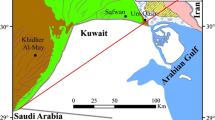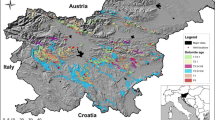Abstract
Naturally high uranium (U) concentrations occur in the groundwater of northern Bavaria (southeastern Germany) although the source(s) and geochemical processes controlling its occurrence are poorly understood. An earlier study identified the weathering of uraniferous apatite as responsible for elevated groundwater U in a part of the region. This present study focuses on a uraniferous dolomite facies in the Triassic sandstone aquifer of northern Bavaria as a potential source of dissolved uranium in the regional groundwater. Hydrogeochemical and mineralogical analytical methods (INAA, ICP-OES, SEP, XRD, C/S measurements), in conjunction with existing hydro- and geochemical datasets, as well as hydrogeochemical modeling approaches indicate a strong connection between groundwater U and the dolomitic facies. Highest groundwater concentrations (max 58.3 µg L−1) occur under slightly alkaline and oxic to slightly reducing conditions. Uranium speciation is dominated by mobile U(VI), predominantly in the form of uranyl-carbonate complexes. Groundwater is undersaturated with respect to U mineral phases. In addition, high values in the dolomite extraction step (SEP) and a positive correlation of dolomite (XRD) and Ca with U (INAA) support the assumption of mobilization from the uraniferous dolomite as a potential source for elevated U concentrations, and hence one of the causes for the geogenic groundwater U problem in this region.








Similar content being viewed by others
References
Abele G, Berger K, Salger M (1962) Die Uranvorkommen im Burgsandstein Mittelfrankens. Geol Bavarica 49:3–90
Bachmaf S, Planer-Friedrich B, Merkel BJ (2008) Effect of sulfate, carbonate, and phosphate on the uranium(VI) sorption behavior onto bentonite. Radiochim Acta 96:359–366
Banning A (2012) Natural arsenic and uranium accumulation and remobilization in different geological environments. Dissertation, RWTH Aachen University
Banning A, Rüde TR (2015) Apatite weathering as a geological driver of high uranium concentrations in groundwater. Appl Geochem 59:139–146
Banning A, Demmel T, Rüde TR, Wrobel M (2013) Groundwater uranium origin and fate control in a river valley aquifer. Environ Sci Technol 47:13941–13948
Breger IA, Deul M (1955) The organic geochemistry of uranium. In: Contributions to the geology of uranium and thorium by the United States geological survey and atomic energy commission for the United Nations international conference on peaceful uses of atomic energy, Geneva, Switzerland, pp 505–510
Briot P (1983) L’environnement hydrogéochimique du calcrete uranifère de Yeelirrie (Australie Occidentale). Miner Deposita 18:191–206
Cappuyns V, Swennen R, Niclaes M (2007) Application of the BCR sequential extraction scheme to dredged pond sediments contaminated by Pb–Zn mining: a combined geochemical and mineralogical approach. J Geochem Explor 93:78–90
Dahlkamp FJ (1979) Uranlagerstätten. Gmelin Handbuch der anorganischen Chemie. Springer, Heidelberg
Deininger RW (1964) Ferrous iron and uranium concentrations and distributions in 100 selected limestones and dolomites. Dissertation, Rice University
Dickinson M, Scott TB (2010) The application of zero-valent iron nanoparticles for the remediation of a uranium-contaminated waste effluent. J Hazard Mater 178(1–3):171–179
Dill HG (1988) Diagenetic and epigenetic U, Ba, and base metal mineralization in the arenaceous Upper Triassic “Burgsandstein”, Southern Germany. Miner Pet 39(2):93–105
Dill HG (2009) A comparative study of uranium–thorium accumulation at the western edge of the Arabian Peninsula and mineral deposits worldwide. Arab J Geosci 4(1):123–146
Dorfner K (1964) Ionenaustauscher. Eigenschaften und Anwendungen. De Gruyter, Berlin
Drever JI (1997) The geochemistry of natural water. Surface and groundwater environments. Prentice Hall, Lebanon
Eichfeld S (2004) Methodische und statistische Untersuchungen zur Anwendbarkeit ausgewählter sequentieller Extraktionsverfahren auf bergbautypische Gesteins- und Bodenmaterialien. Dissertation, Friedrich-Schiller-Universität Jena
Fernandez HM, Franklin MR, Veiga LHS, Freitas P, Gmiero LA (1996) Management of uranium mill tailing: geochemical processes and radiological risk assessment. J Environ Radioact 30(1):69–95
Finch R, Murakami T (1999) Systematics and paragenesis of uranium minerals. In: Burns PC, Finch R (eds) Uranium: mineralogy, geochemistry and the environment. Reviews in Mineralogy 38, Mineralogical Society of America, Washington, DC, pp 91–180
Füchtbauer H (1988) Sedimente und Sedimentgesteine. Schweizerbart, Stuttgart
Gruner JW (1956) Concentration of uranium in sediments by multiple migration-accretion. Econ Geol 51:495–520
Heinrichs G, Udluft P (1999) Natural arsenic in Triassic rocks: a source of drinking water contamination in Bavaria, Germany. Hydrogeol J 7:468–476
Huang PM, Li Y, Summer EM (2011) Handbook of soil sciences. Properties and processes, 2nd edn. CRC, Boca Raton
Jurgens BC, McMahon PB, Chapelle FH, Eberts SM (2009) An excel workout for identifying redox processes in ground water. U.S. Geological Survey Open-File Report 2009-1004
Kelly SD, Newville MG, Cheng L, Kemner KM, Sutton SR, Fenter P, Sturchio NC, Spötl C (2003) Uranyl incorporation in natural calcite. Environ Sci Technol 37:1284–1287
Kurttio P, Auvinen A, Salonen L, Saha H, Pekkanen J, Makelainen I, Varisanen SB, Penttilla IM, Komulainen H (2002) Renal effects of uranium in drinking water. Environ Health Perspect 110(4):337–342
Langmuir D (1997) Aqueous environmental geochemistry. Prentice Hall, New Jersey
Maia F, Pinto C, Waerenborgh JC, Gonçalves MA, Prazeres C, Carreira O, Sério S (2012) Metal partitioning in sediments and mineralogical controls on the acid mine drainage in Ribeira da Água Forte (Aljustrel, Iberian Pyrite Belt, Southern Portugal). Appl Geochem 27(6):1063–1080
Nakata PA (2003) Advances in our understanding of calcium oxalate crystal formation and function in plants. Plant Sci 164:901–909
Nash JT (1979) Geology, petrology, and chemistry of the Leadville Dolomite: host for uranium at the Pitch Mine, Saguache County, Colorado. U.S. Geological Survey
Nolan J, Weber KA (2015) Natural uranium contamination in major U. S. aquifers linked to nitrate. Environ Sci Technol Lett 2:215–220
O’Loughlin EJ, Kelly SD, Cook RE, Csencsits R, Kemner KM (2003) Reduction of uranium(VI) by mixed iron(II)/iron(III) hydroxide (green rust): formation of UO2 nanoparticles. Environ Sci Technol 37(4):721–727
Parkhurst DL, Appelo CAJ (2013) Description of input and examples for PHREEQC version 3—a computer program for speciation, batch-reaction, one-dimensional transport, and inverse geochemical calculations. Denver, Colorado: U.S. Geological Survey, U.S. Department of the Interior, Techniques and Methods, book 6, chapter A43
Radespiel-Tröger M, Meyer M (2013) Association between drinking water uranium content and cancer risk in Bavaria, Germany. Int Arch Occup Environ Health 86:767–776
Rakovan J, Reeder RJ, Elzinga EJ, Cherniak DJ, Tait CD, Morris DE (2002) Structural characterization of U(VI) in apatite by X-ray absorption spectroscopy. Environ Sci Technol 36:3114–3117
Regenspurg S, Margot-Roquier C, Harfouche M, Froidevaux P, Steinmann P, Junier P, Bernier-Latmani R (2010) Speciation of naturally-accumulated uranium in an organic-rich soil of an alpine region (Switzerland). Geochim Cosmochim Acta 74:2082–2098
Reinhardt L, Ricken W (2000) The stratigraphic and geochemical record of Playa Cycles: monitoring a Pangaean monsoon-like system (Triassic, Middle Keuper, S. Germany). Palaeogeogr Palaeocl 161:205–227
Schnug E, Lottermoser BG (2013) Fertilizer-derived uranium and its threat to human health. Environ Sci Technol 47(6):2433–2434
Starinsky A, Katz A, Kolodny Y (1982) The incorporation of uranium into diagenetic phosphorite. Geochim Cosmochim Acta 46:1365–1374
Sturchio NC, Antonio MR, Soderholm L, Sutton SR, Brannon JC (1998) Tetravalent uranium in calcite. Science 281:971–973
Tessier A, Campbell PGC, Bisson M (1979) Sequential extraction procedure for the speciation of particulate trace metals. Anal Chem 51(7):844–851
van Berk W, Fu Y (2017) Redox roll-front mobilization of geogenic uranium by nitrate input into aquifers: risks for groundwater resources. Environ Sci Technol 51:337–345
Wagner SE, Burch JB, Bottai M, Puett R, Porter D, Bolick-Aldrich S, Temples T, Wilkerson RC, Vena JE, Hébert JR (2011) Groundwater uranium and cancer incidences in South Carolina. Cancer Cause Control 22:41–50
Welte DH (1962) Sedimentologische Untersuchung uranhaltiger Keupersedimente aus der Umgebung von Lichtenfels bei Coburg. Geol Bavarica 49:91–123
Wenzel WW, Kirchbaumer N, Prohaska T, Stingeder G, Lombi E, Adriano DC (2001) Arsenic fractionation in soils using an improved sequential extraction procedure. Anal Chim Acta 436:309–323
Wrenn ME, Durbin PW, Howard B, Lipsztein J, Rundo J, Still ET et al (1985) Metabolism of ingested U and Ra. Health Phys 48(5):601–633
Acknowledgements
The Bavarian Environment Agency (LfU) is acknowledged for providing hydrochemical and geochemical data. The authors thank Dr. Thomas Reinecke, Mr. Oliver Schübbe and Mr. Frank Hansen (all Ruhr-Universität Bochum) for assistance in experimental and analytical work, and M.Sc. Alexander Potrafke (Universität Innsbruck) for support during rock sampling in the field and for discussions.
Author information
Authors and Affiliations
Corresponding author
Rights and permissions
About this article
Cite this article
Steffanowski, J., Banning, A. Uraniferous dolomite: a natural source of high groundwater uranium concentrations in northern Bavaria, Germany?. Environ Earth Sci 76, 508 (2017). https://doi.org/10.1007/s12665-017-6848-6
Received:
Accepted:
Published:
DOI: https://doi.org/10.1007/s12665-017-6848-6




